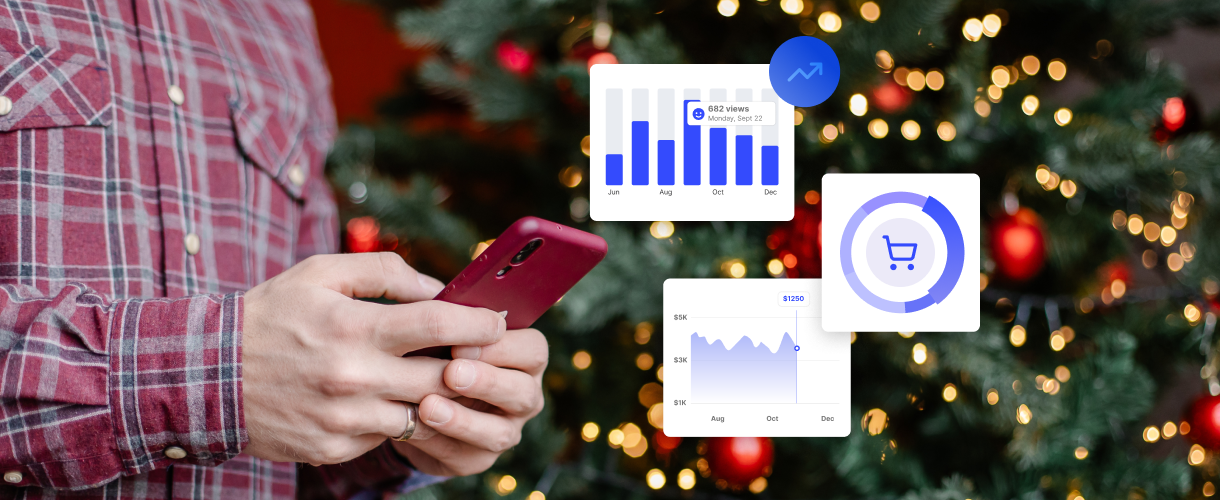Call it pre-Black Friday Sales, Black Friday, Cyber Monday, or Shop Local Saturday, as the holiday season approaches, there’s a buzz of excitement and anticipation for gift-giving and festive celebrations.
This holiday season brings a mix of joy and urgency for shoppers around the world, all on the hunt for perfect presents, unbeatable deals, and memorable holiday experiences.
And for businesses, it’s a prime opportunity to connect with customers and boost sales.
Now, the holiday shopping season is constantly evolving, influenced by changing consumer behaviors and new technologies. Recently, the convenience of online shopping has transformed how people approach their holiday lists—especially because of social media.
More shoppers are turning to their devices for everything they need, from stocking stuffers to big-ticket items. With mobile shopping, personalized experiences, and flexible payment options are becoming the norm, holiday shopping is now more exciting and convenient than ever before.
Take a look at some of the latest holiday shopping stats to see these trends in action.
Key Black Friday and Holiday Shopping Stats and Trends
- Online Sales: Online sales played a significant role, contributing $276.8 billion to the total, an 8.2% increase from 2022. This highlights the growing trend of consumers preferring the convenience of online shopping during the holiday season (National Retail Federation).
- Mobile Shopping: Mobile devices accounted for 54% of online sales on Black Friday, emphasizing the importance of mobile-friendly shopping experiences (Digital Commerce 360).
- Top-Selling Categories: Electronics, apparel, toys, and beauty products were among the top-selling categories during the holiday season. Electronics, in particular, saw substantial growth, with a 9.3% increase in sales year-over-year (Bain).
- Consumer Behavior: The average consumer spent $321.41 over the Black Friday weekend, with 70% of that amount going towards gifts. Additionally, the “buy now, pay later” (BNPL) option saw significant use, with orders up 72% and revenue increasing by 47% (Digital Commerce 360).
- In-Store vs. Online: While 76.2 million people visited physical stores during Black Friday, online shopping continued to dominate, with 90.6 million consumers shopping online (National Retail Federation).
- eCommerce Sales: Online sales are expected to see significant growth in 2024, with projections indicating an increase between 10.3% and 12.8% year-over-year. This would bring eCommerce holiday sales to between $278 billion and $284 billion (Deloitte United States).
Holiday Shopping Consumer Behavior Trends
- Digital Dominance: A substantial portion of holiday shopping will continue to shift online. Salesforce predicts that Black Friday will remain a major online shopping day, with 72% of shoppers preferring to make their purchases online for convenience and better deals (Salesforce).
- Loyalty Programs: Retailers are likely to focus on loyalty programs to engage repeat customers. It’s anticipated that 2 out of 5 holiday purchases will be made by loyal repeat buyers, emphasizing the importance of personalized shopping experiences and exclusive member perks (Salesforce).
- Sustainability and Value: Consumers are increasingly prioritizing sustainability and overall value in their holiday purchases. Retailers offering eco-friendly products and services, as well as bundled deals and loyalty rewards, are expected to attract more shoppers (HappyOrNot).
Social Media’s Impact on Holiday Sales
In recent years, social media has played an increasingly significant role in driving holiday sales. Here are some key insights on how social media influences shopping during the holiday season:
- Growing Influence: In 2023, approximately 47% of U.S. consumers made purchases directly through social media platforms. This trend is expected to continue growing in 2024, with many consumers preferring the convenience and engagement of social media shopping over traditional e-commerce sites (HubSpot Blog).
- Preferred Discovery Platform: Social media is becoming the go-to platform for product discovery, particularly among younger consumers. For those aged 18-44, social media platforms like Instagram and TikTok are favored for finding new products (HubSpot Blog).
- Social Commerce: The importance of social commerce is highlighted by the fact that 84% of social media marketers believe that consumers will buy products directly through social apps more frequently than through brand websites or third-party platforms in 2024 (HubSpot Blog).
- Engagement and Community Building: Building active online communities on platforms like Facebook, Instagram, and YouTube has been shown to enhance customer loyalty and engagement. Brands that leverage these platforms effectively can create dedicated follower bases that are more likely to make purchases during the holiday season (HubSpot Blog).
- Influencer Marketing: Working with trusted influencers can significantly boost sales. Influencers help bridge the trust gap, making consumers feel more comfortable purchasing products promoted on social media. This strategy is particularly effective in converting social media engagement into sales (HubSpot Blog).
Social media continues to evolve, its impact on holiday shopping is likely to grow, making it a big component of any comprehensive holiday marketing strategy.
Wrapping It Up
Holiday shopping is changing rapidly, with online shopping and personalization leading the way. The significant growth in online sales and the increasing use of mobile devices highlight the need for businesses to invest in strong e-commerce platforms and mobile-friendly experiences. Understanding consumer behavior, like the rise in BNPL options and the influence of social media on shopping habits, is essential for effective holiday marketing.
Looking ahead, digital dominance will continue to shape holiday shopping. Retailers need to engage customers through personalized experiences, leverage loyalty programs, and embrace sustainability to meet the evolving demands of modern consumers. By staying on top of these trends and adapting accordingly, businesses can stay competitive and successful during the holiday season and beyond.











